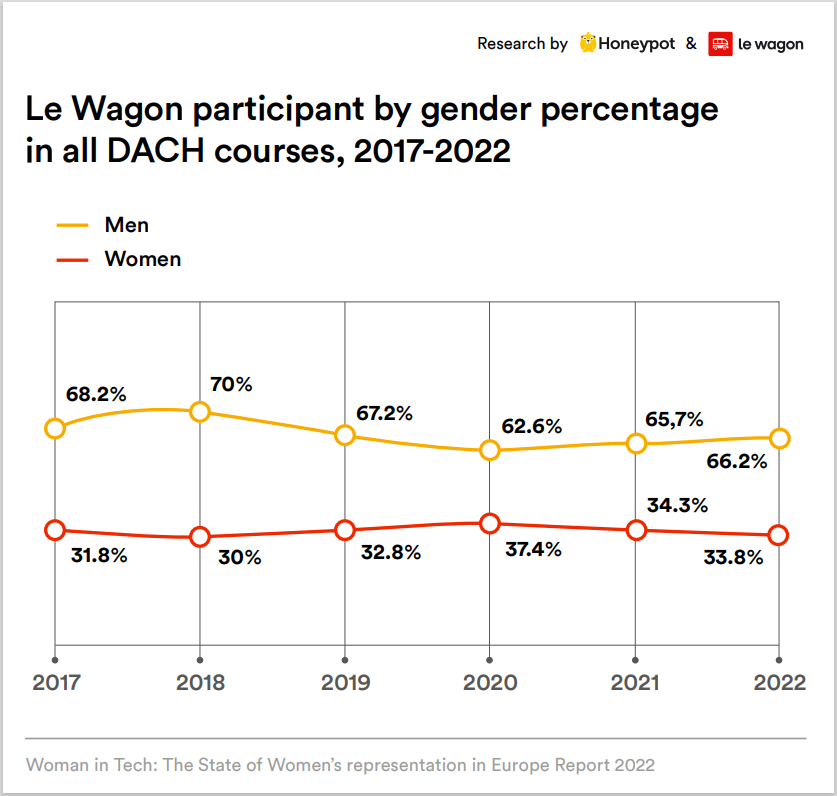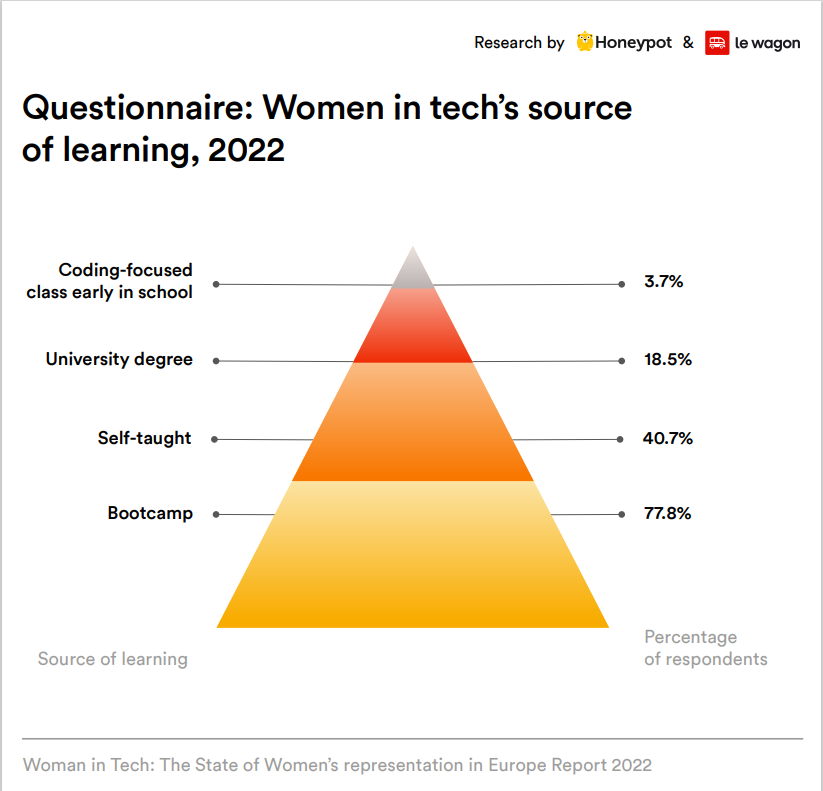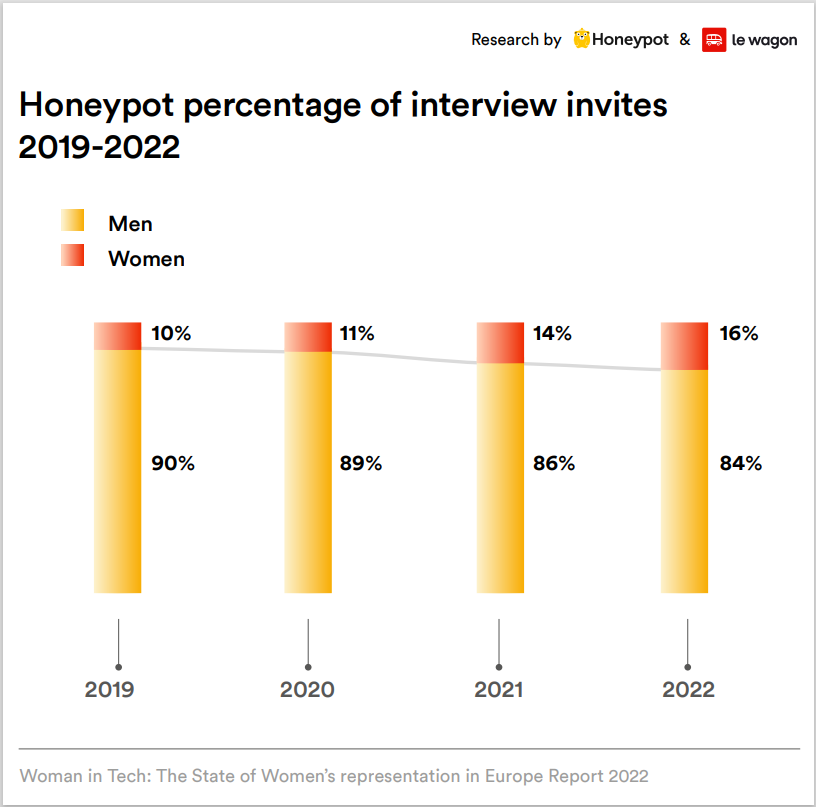It’s not a secret that women are underrepresented in tech. In Europe, around 28% of tech workers are women. This number is undeniably low, but this is also a number focused on the tech industry. When we look into numbers in the broader workforce, the picture becomes clearer and all the more problematic. According to the World Economic Forum (WEF), it will take 151 years for women to achieve gender parity in the workplace.
But what about the tech industry? Though things seem to be going better in the tech industry, we’re still years away from reaching gender parity in the DACH region and Europe. And yet, women bring invaluable perspectives and talent to tech, as well as a swift and innovative change to the industry.
Today, Honeypot and Le Wagon are pleased to release brand new data highlighting the percentage of female roles in the tech industry, from schooling to salary. We do so to promote awareness about the shortfall in women’s representation across Europe and share insights into sore spots, as well as how leaders in the industry can encourage female growth and uptake in the world of tech. With this report, we believe we can inform, inspire and create more space for women in tech.
By 2030, the demand for skilled tech workers is bound to exceed the supply. The need for skilled tech talents is growing by the minute, which creates a perfect opportunity for more female tech professionals. However, is the tech industry doing enough to get more women to sign up and learn how to code? Flexible schedules, remote working possibilities, and a steady paycheck are attractive work qualities for working mothers. So, why don't we see more women in coding courses?
Female Participation in Coding Courses
Despite an upward trend that has continued since 2017, we can see that the COVID-19 pandemic had put a dumper on that trend and since 2020, the participation of women in coding bootcamps with LeWagon has seen a steady decrease.

What this data shows is significant female underrepresentation in coding bootcamps and courses. Yet when we interviewed women working in tech, most of them had found their way into the industry via these very same courses rather than a university degree or school-based coding class. So, what keeps more women from learning to code?

Even when women make it into the industry they are severely outnumbered by male colleagues. These data provide valuable insights into the state of female representation in tech teams and explore why these numbers are still so low.
YES, you can get the full report HERE.
In 2022, we found that women continue to receive fewer interview invites than their male counterparts.

As seen in this chart, interview invites are fewer for women. 16% of total interview invites went to women in 2022, while 34% of total talents on the Honeypot platform are women.
Honeypot’s investigation into a lack of interview invites for women indicates that women may struggle more to find jobs in tech than their male counterparts. This was further confirmed by our survey data, where 27% of the women surveyed were not able to find a job as a programmer, despite the industry’s high demand and a large number of open roles.
The IT Talent Shortage in Europe
Left unchecked, in the next 5 years, the extreme IT talent shortage will be one of the biggest threats Europe's tech industry will be forced to face. Honeypot sees this as an opportunity to promote diversity and inclusion in the workforce. Tech companies that want to stay ahead of the curve will have to take a stand and make more room for women in their tech teams. Their survival might depend on it.
Women Get into Tech Later
Another interesting insight comes from the survey led by Honeypot and LeWagon. When asked at what age they got into coding and started learning, the voices converged. 74% of our interviewees got into tech after the age of 26. It’s interesting to note that most male developers are starting a career in tech at a much earlier age, fresh out of school, or college. Could this ‘late’ start, alongside the diverse educational background the women in our survey share, be responsible for receiving fewer interview invites?
'I think tech benefits from a diverse workforce and I think women benefit when their teams have women on them. It is a good job with flexibility and career opportunities,' said one of the interviewees when asked if she has any wisdom for women who are thinking but are not yet sure about pursuing a tech role.
Though much of the focus on women in tech has revolved around the US and the UK, our research dives into the status quo in Europe. Focusing on the DACH (Germany, Austria and Switzerland) region and offering comparisons to the UK and global industries, this report provides startling new insight that women’s representation in tech is not just less common in Europe - it is sometimes going backward.
Methodology
To create this report we used data specified by hiring companies on the Honeypot platform. The roles considered for this report were software developers, engineers, and data professionals. Interview invites missing significant information (like position or company location) as well as unusually low or high salaries were removed to ensure consistent data comparison and avoid extreme outliers. Gender was determined based on both external libraries making determinations based on first names as well as a Python gender detector. Le Wagon data is provided by Web Development and Data Science bootcamp participants in the DACH region as well as other world regions.
In order to provide further insights into women’s journey in tech, we also conducted a survey interviewing 27 interviewees across Germany, the UK, and other parts of the world. In this report, information is split into ‘by the numbers’ insights (analyzing Honeypot and Le Wagon data) and ‘by the voices’ insights (analyzing survey responses).
WANNA KNOW MORE? Get the full report to uncover further insights into women's educational background, concerns, and difficulties during the transition into tech.
Find the full Women in Tech 2022 Report HERE!
The full report will give you access to:
Data on female and female-identifying participants in coding bootcamps in the DACH region and Europe.
Honeypot data on female representation in tech teams in the DACH region. Based on a survey done via the XING network.
A further breakdown of data extracted by the Honeypot platform regarding the percentage of female signups and interview invites.
2022 data on the gender pay gap in the DACH region.
Insights (by the voices of women working in tech) on age, concerns, the importance of mentorship, and the difficulty to find a job within a tech team.


